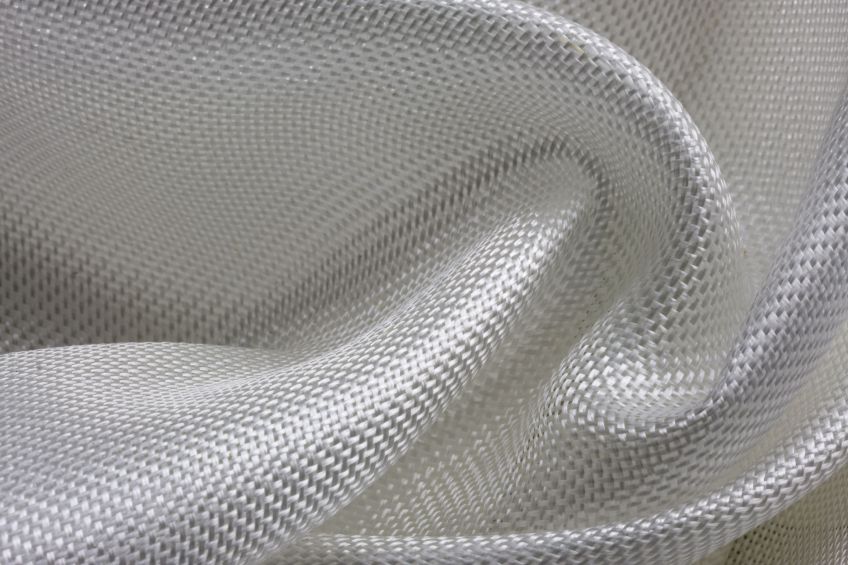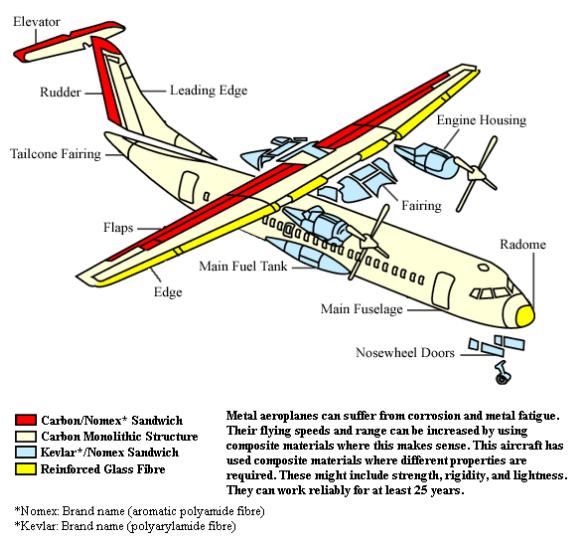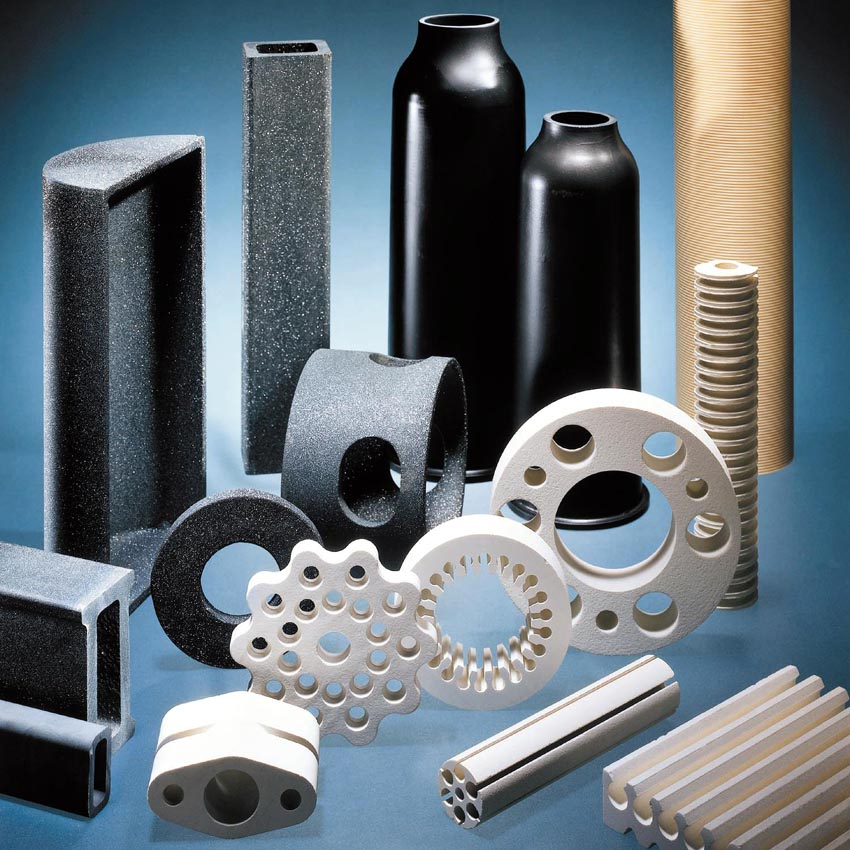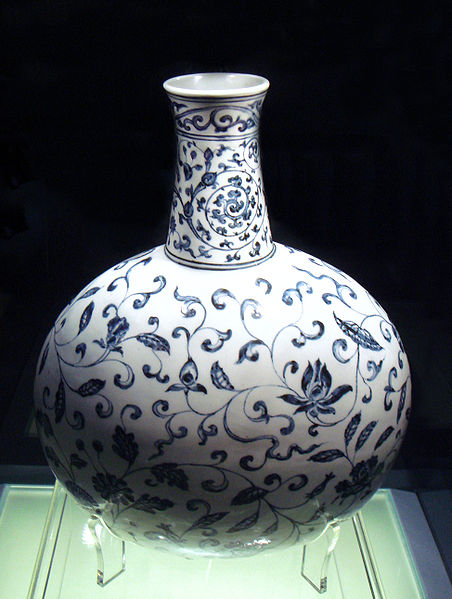What are Advanced Composite Materials ?
Advanced Composite Materials are High-structural-strength materials created by combining one or more stiff, high-strength reinforcing fibers with a compatible resin system. Advanced composites can be substituted for metals in many structural applications.
 Advanced Composite Material
Advanced Composite Material
Composite materials applicable to aerospace and automotive construction consist of a high-strength, high-modulus fiber system embedded within an essentially homogeneous matrix which can be fabricated from either thermoplastic or thermosetting resins.
Composite material or composite, any material made from at least two discrete substances, such as concrete. Many materials are produced as composites, such as the fiberglass-reinforced plastics used for automobile bodies and boat hulls, but the term usually is used to describe any of various modern industrially manufactured composites, such as carbon fiber–reinforced plastics. Composite materials allow a blending of properties of the separate components. Carbon fiber–reinforced plastics combine the high strength and stiffness of the fiber with the low weight and resistance to fracture of the polymeric matrix. Glass, wood, and other kinds of fibers are also used, and the fibers may be layered or woven. Other modern composites include wood fiber or chunks in a concrete matrix and silicon carbide, a ceramic, in a titanium matrix.
A material system composed of a mixture or combination of two or more constituents that differ in form or material composition and are essentially insoluble in each other. In principle, composites can be constructed of any combination of two or more materials—metallic, organic, or inorganic but the constituent forms are more restricted. The matrix is the body constituent, serving to enclose the composite and give it bulk form. Major structural constituents are fibers, particles, laminae or layers, flakes, fillers, and matrices. They determine the internal structure of the composite. Usually, they are the additive phase.
Several body parts are made of a advanced composite materials
Because the different constituents are intermixed or combined, there is always a contiguous region. It may simply be an interface, that is, the surface forming the common boundary of the constituents. An interface is in some ways analogous to the grain boundaries in monolithic materials. In some cases, the contiguous region is a distinct added phase, called an interphase. Examples are the coating on the glass fibers in reinforced plastics and the adhesive that bonds the layers of a laminate together. When such an interphase is present, there are two interfaces, one between the matrix and the interphase and one between the fiber and the interface.
Several body parts are made of a carbon fiber composite materials
Interfaces are among the most important yet least understood components of a composite material. In particular, there is a lack of understanding of processes occurring at the atomic level of interfaces, and how these processes influence the global material behavior. There is a close relationship between processes that occur on the atomic, microscopic, and macroscopic levels.
In fact, knowledge of the sequence of events occurring on these different levels is important in understanding the nature of interfacial phenomena. Interfaces in composites, often considered as surfaces, are in fact zones of compositional, structural, and property gradients, typically varying in width from a single atom layer to micrometers. Characterization of the mechanical properties of interfacial zones is necessary for understanding mechanical behavior.
Advanced composites comprise structural materials that have been developed for high-technology applications, such as airframe structures, for which other materials are not sufficiently stiff. In these materials, extremely stiff and strong continuous or discontinuous fibers, whiskers, or small particles are dispersed in the matrix. A number of matrix materials are available, including carbon, ceramics, glasses, metals, and polymers.
Advanced composites possess enhanced stiffness and lower density compared to fiber-glass and conventional monolithic materials. While composite strength is primarily a function of the reinforcement, the ability of the matrix to support the fibers or particles and to transfer load to the reinforcement is equally important. Also, the matrix frequently dictates service conditions, for example, the upper temperature limit of the composite.
The use of fiber-reinforced materials in engineering applications has grown rapidly. Selection of composites rather than monolithic materials is dictated by the choice of properties. The high values of specific stiffness and specific strength may be the determining factor, but in some applications wear resistance or strength retention at elevated temperatures is more important. A composite must be selected by more than one criterion, although one may dominate. Components fabricated from advanced organic-matrix–fiber-reinforced composites are used extensively on commercial aircraft as well as for military transports, fighters, and bombers. The propulsion system, which includes engines and fuel, makes up a significant fraction of aircraft weight (frequently 50%) and must provide a good thrust-to-weight ratio and efficient fuel consumption. The primary means of improving engine efficiency are to take advantage of the high specific stiffness and strength of composites for weight reduction, especially in rotating components, where material density directly affects both stress levels and critical dynamic characteristics, such as natural frequency and flutter speed.
Composites consisting of resin matrices reinforced with discontinuous glass fibers and continuous-glass-fiber mats are widely used in truck and automobile components bearing light loads, such as interior and exterior panels, pistons for diesel engines, drive shafts, rotors, brakes, leaf springs, wheels, and clutch plates.
The excellent electrical insulation, formability, and low cost of glass-fiber-reinforced plastics have led to their widespread use in electrical and electronic applications ranging from motors and generators to antennas and printed circuit boards.
Composites are also used for leisure and sporting products such as the frames of rackets, fishing rods, skis, golf club shafts, archery bows and arrows, sailboats, racing cars, and bicycles.
You might also like
| Composite Materials What is Composite Materials ? Composite... | Advanced Ceramics What is Advanced Ceramic ? A ceramic is... | What is Ceramics ? Ceramics - A Definition A ceramic is an... | Types of Materials Metals Metals are elements that generally... |




 Alloy Suppliers
Alloy Suppliers
 Aluminum
Aluminum
 Aluminum Extrusions
Aluminum Extrusions
 Copper-Brass-Bronze
Copper-Brass-Bronze
 Nickel
Nickel
 Magnets
Magnets
 Stainless Steel
Stainless Steel
 Stainless Steel Tubing
Stainless Steel Tubing
 Steel Service Centers
Steel Service Centers
 Titanium
Titanium
 Tungsten
Tungsten
 Wire Rope
Wire Rope